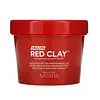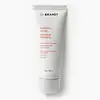What's inside
What's inside
 Key Ingredients
Key Ingredients

 Benefits
Benefits

 Concerns
Concerns

 Ingredients Side-by-side
Ingredients Side-by-side

Water
Skin ConditioningKaolin
AbrasiveSilica
AbrasiveButylene Glycol
HumectantSolum Diatomeae
AbrasiveHectorite
AbsorbentAlcohol Denat.
AntimicrobialGlyceryl Stearate
EmollientGlycerin
Humectant1,2-Hexanediol
Skin ConditioningHydroxyacetophenone
AntioxidantCI 77491
Cosmetic ColorantCellulose Gum
Emulsion StabilisingTetrasodium Pyrophosphate
BufferingXanthan Gum
EmulsifyingSalicylic Acid
MaskingPaullinia Cupana Fruit Extract
Skin ConditioningLactic Acid
BufferingCitrus Aurantium Bergamia Fruit Oil
MaskingDisodium EDTA
Ethylhexylglycerin
Skin ConditioningTromethamine
BufferingLavandula Angustifolia Oil
MaskingPortulaca Oleracea Extract
Skin ConditioningRosmarinus Officinalis Leaf Oil
MaskingAniba Rosaeodora Wood Oil
AstringentLimonene
PerfumingLinalool
PerfumingWater, Kaolin, Silica, Butylene Glycol, Solum Diatomeae, Hectorite, Alcohol Denat., Glyceryl Stearate, Glycerin, 1,2-Hexanediol, Hydroxyacetophenone, CI 77491, Cellulose Gum, Tetrasodium Pyrophosphate, Xanthan Gum, Salicylic Acid, Paullinia Cupana Fruit Extract, Lactic Acid, Citrus Aurantium Bergamia Fruit Oil, Disodium EDTA, Ethylhexylglycerin, Tromethamine, Lavandula Angustifolia Oil, Portulaca Oleracea Extract, Rosmarinus Officinalis Leaf Oil, Aniba Rosaeodora Wood Oil, Limonene, Linalool
Water
Skin ConditioningSilica
AbrasiveButylene Glycol
HumectantBenzyl Alcohol
PerfumingMannitol
HumectantAlcohol Denat.
AntimicrobialXanthan Gum
EmulsifyingCellulose
AbsorbentLavandula Angustifolia Oil
MaskingGlycolic Acid
BufferingMenthone Glycerin Acetal
RefreshingEnantia Chlorantha Bark Extract
Skin ConditioningSodium Hydroxide
BufferingDisodium EDTA
Glycerin
HumectantSalicylic Acid
MaskingOleanolic Acid
Skin ConditioningAcrylates Copolymer
Caprylic/Capric Triglyceride
MaskingTocopheryl Acetate
AntioxidantHydroxypropyl Methylcellulose
Emulsion StabilisingIris Florentina Root Extract
MaskingSodium Benzoate
MaskingPotassium Sorbate
PreservativeRosa Multiflora Fruit Extract
MaskingCI 77007
Cosmetic ColorantCI 77891
Cosmetic ColorantCI 77120
Cosmetic ColorantWater, Silica, Butylene Glycol, Benzyl Alcohol, Mannitol, Alcohol Denat., Xanthan Gum, Cellulose, Lavandula Angustifolia Oil, Glycolic Acid, Menthone Glycerin Acetal, Enantia Chlorantha Bark Extract, Sodium Hydroxide, Disodium EDTA, Glycerin, Salicylic Acid, Oleanolic Acid, Acrylates Copolymer, Caprylic/Capric Triglyceride, Tocopheryl Acetate, Hydroxypropyl Methylcellulose, Iris Florentina Root Extract, Sodium Benzoate, Potassium Sorbate, Rosa Multiflora Fruit Extract, CI 77007, CI 77891, CI 77120
 Reviews
Reviews

Ingredients Explained
These ingredients are found in both products.
Ingredients higher up in an ingredient list are typically present in a larger amount.
Alcohol Denat. is an alcohol with a denaturant property. It is created by mixing ethanol with other additives.
This ingredient gets a bad rep because it is irritating and drying - mostly due to its astringent property. Astringents draw out natural oils in tissue, constricting pores and leaving your skin dried out.
However, alcohol denat. is not all that bad.
Due to its low molecular weight, alcohol denat. tends to evaporate quickly. One study on pig skin found half of applied alcohol evaporated in 10 seconds and less than 3% stayed on skin.
This also helps other ingredients become better absorbed upon application.
Studies are conflicted about whether this ingredient causes skin dehydration. One study from 2005 found adding emollients to propanol-based sanitizer decreased skin dryness and irritation. Another study found irritation only occurs if your skin is already damaged.
Small amounts of alcohol are generally tolerated by oily skin or people who live in humid environments.
The rule of thumb is if this alcohol is near the end of an ingredients list, it will probably not affect your skin much.
Also...
This ingredient has antimicrobial and solvent properties.
The antimicrobial property helps preserve products and increase their shelf life. As a solvent, it helps dissolve other ingredients.
Other types of astringent alcohols include:
Learn more about Alcohol Denat.Butylene Glycol (or BG) is used within cosmetic products for a few different reasons:
Overall, Butylene Glycol is a safe and well-rounded ingredient that works well with other ingredients.
Though this ingredient works well with most skin types, some people with sensitive skin may experience a reaction such as allergic rashes, closed comedones, or itchiness.
Learn more about Butylene GlycolDisodium EDTA plays a role in making products more stable by aiding other preservatives.
It is a chelating agent, meaning it neutralizes metal ions that may be found in a product.
Disodium EDTA is a salt of edetic acid and is found to be safe in cosmetic ingredients.
Learn more about Disodium EDTAGlycerin is already naturally found in your skin. It helps moisturize and protect your skin.
A study from 2016 found glycerin to be more effective as a humectant than AHAs and hyaluronic acid.
As a humectant, it helps the skin stay hydrated by pulling moisture to your skin. The low molecular weight of glycerin allows it to pull moisture into the deeper layers of your skin.
Hydrated skin improves your skin barrier; Your skin barrier helps protect against irritants and bacteria.
Glycerin has also been found to have antimicrobial and antiviral properties. Due to these properties, glycerin is often used in wound and burn treatments.
In cosmetics, glycerin is usually derived from plants such as soybean or palm. However, it can also be sourced from animals, such as tallow or animal fat.
This ingredient is organic, colorless, odorless, and non-toxic.
Glycerin is the name for this ingredient in American English. British English uses Glycerol/Glycerine.
Learn more about GlycerinLavandula Angustifolia Oil is more commonly known as lavender essential oil. It is considered a fragrancing ingredient.
Lavender imparts a famous scent. While the smell is lovely, this ingredient and may sensitize skin in topical products. This is because about 85% of the oil is made up of linalool and linalyl acetate.
When exposed to air, these two compounds become strong allergens. This ingredient exhibits cytotoxicity at low concentrations; amounts of 0.25% have been shown to damage skin cells.
A study from Japan found this ingredient caused lavender sensitivity after widespread exposure.
Lavender essential oil has some antimicrobial, antibacterial, and anti-inflammatory properties. However, the cons of this ingredient may outweight the pros.
More research is needed to confirm lavender essential oil's effects when used in aromatherapy.
Lavandula Angustifolia is known as the English Lavender and famous for creating purple fields in Provence, France.
Learn more about Lavandula Angustifolia OilSalicylic Acid (also known as beta hydroxy acid or BHA) is a well-known ingredient for treating skin that struggles with acne and clogged pores. It exfoliates both the skin's surface and deep within the pores to help clear out buildup, control oil, and reduce inflammation.
Unlike AHAs (alpha hydroxy acids), salicylic acid is oil-soluble. This allows it to penetrate into pores which makes it especially effective for treating blackheads and preventing future breakouts.
Salicylic acid is also known for its soothing properties. It has a similar structure to aspirin and can calm inflamed or irritated skin, making it a good option for acne-prone skin that is also sensitive.
Concentrations of 0.5-2% are recognized by the U.S. FDA as an over-the-counter topical acne product.
It can cause irritation and/or dryness if one's skin already has a compromised moisture barrier, so it's best to focus on repairing that before introducing this ingredient into your routine.
While salicylic acid does not increase sun sensitivity, it’s still important to wear sunscreen daily to protect your skin.
If you are looking for the ingredient called BHA or Butylated Hydroxyanisole, click here.
Learn more about Salicylic AcidSilica, also known as silicon dioxide, is a naturally occurring mineral. It is used as a fine, spherical, and porous powder in cosmetics.
Though it has exfoliant properties, the function of silica varies depending on the product.
The unique structure of silica enhances the spreadability and adds smoothness, making it a great texture enhancer.
It is also used as an active carrier, emulsifier, and mattifier due to its ability to absorb excess oil.
In some products, tiny microneedles called spicules are made from silica or hydrolyzed sponge. When you rub them in, they lightly polish away dead skin layers and enhance the penetration of active ingredients.
Learn more about SilicaWater. It's the most common cosmetic ingredient of all. You'll usually see it at the top of ingredient lists, meaning that it makes up the largest part of the product.
So why is it so popular? Water most often acts as a solvent - this means that it helps dissolve other ingredients into the formulation.
You'll also recognize water as that liquid we all need to stay alive. If you see this, drink a glass of water. Stay hydrated!
Learn more about WaterXanthan gum is used as a stabilizer and thickener within cosmetic products. It helps give products a sticky, thick feeling - preventing them from being too runny.
On the technical side of things, xanthan gum is a polysaccharide - a combination consisting of multiple sugar molecules bonded together.
Xanthan gum is a pretty common and great ingredient. It is a natural, non-toxic, non-irritating ingredient that is also commonly used in food products.
Learn more about Xanthan Gum